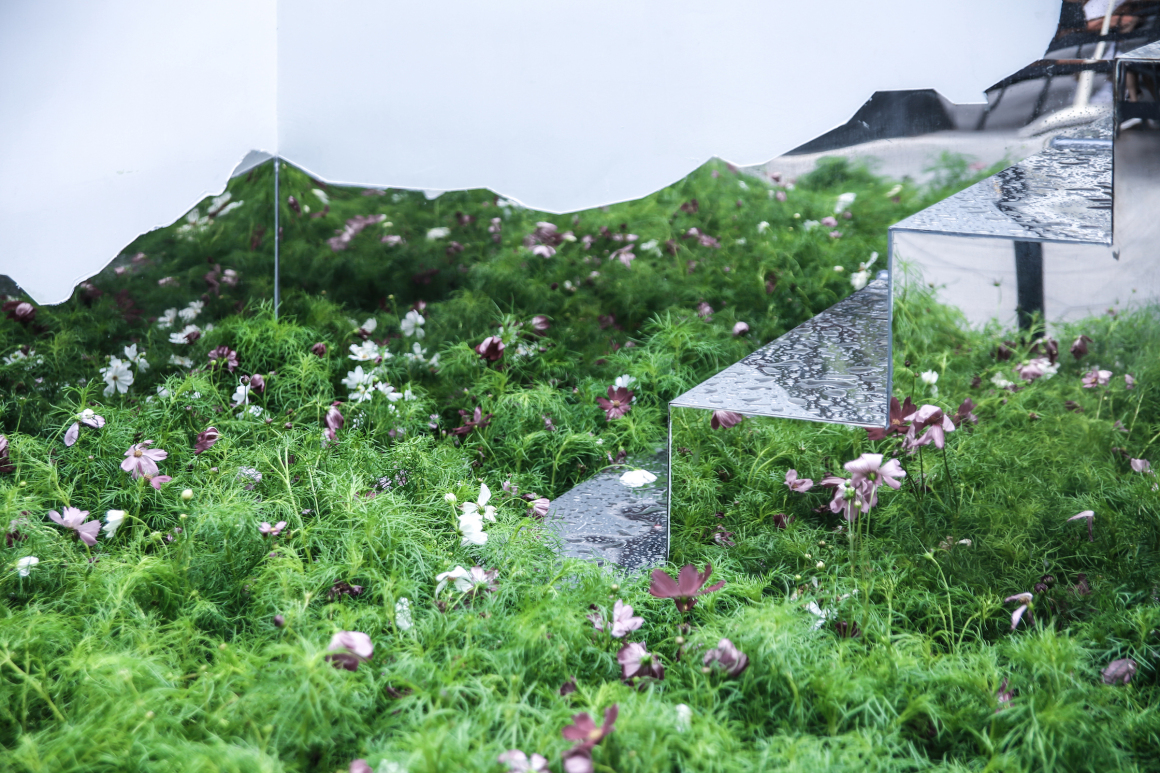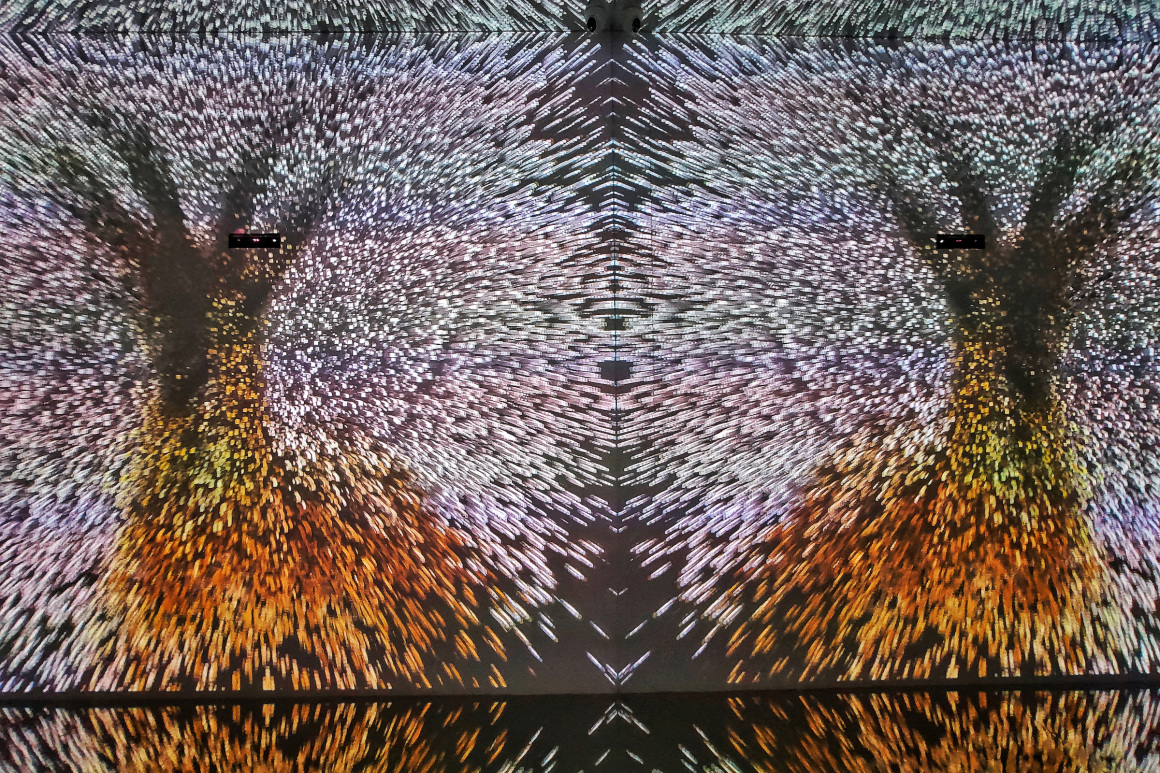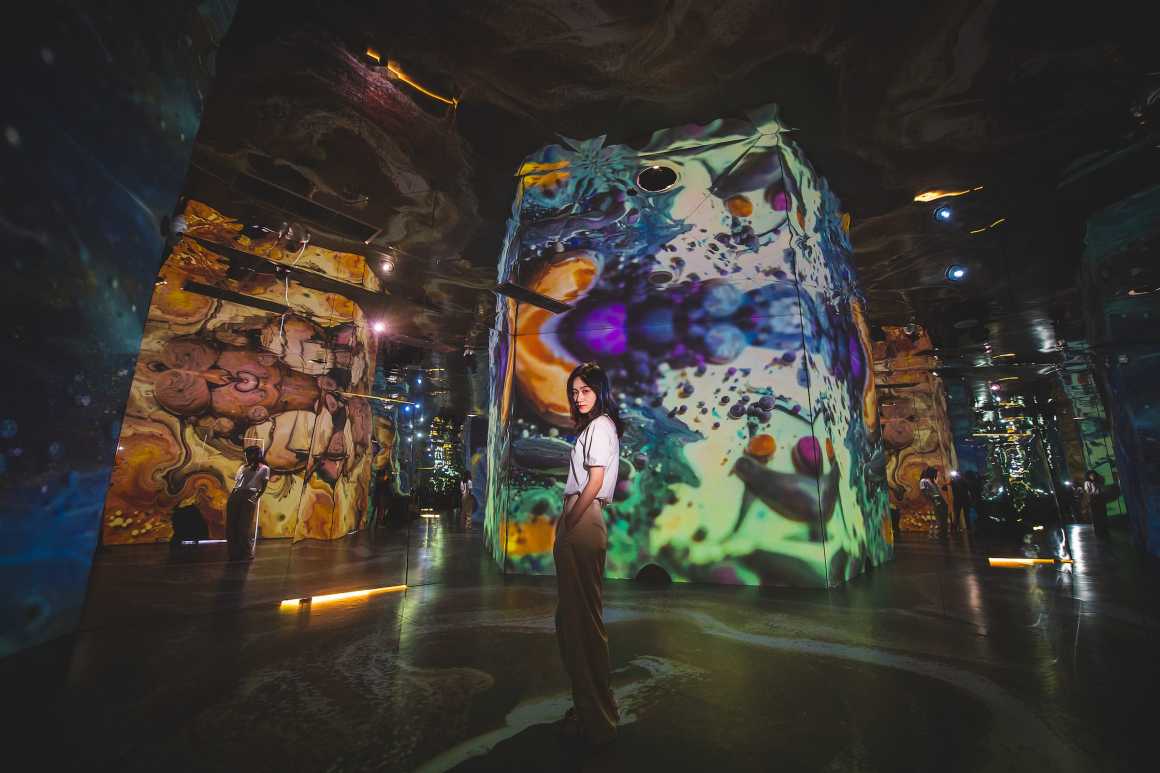本文由 一本造建筑设计工作室 授权mooool发表,欢迎转发,禁止以mooool编辑版本转载。
Thanks One Take Architects for authorizing the publication of the project on mooool. Text description provided by One Take Architects.
一本造:曼陀罗之丘,一个内向的花园,悬浮于都市的理想城。这座数字艺术博物馆,坐落于北京最繁华的都市中心,却形成了绝对内向的空间关系。
外部的空间,也如同迷宫——错落的台阶带来透视错觉的惊喜,激发身体行为与建筑的互动关系;朴拙的石块倒映在南伽巴瓦峰天际线中,令它与成熟的都市氛围割裂开,仿佛天外来物。无数的未知,偶然和惊喜,都围绕在它的周围。
One Take Architects:Mandalas Pop-up Digital Art Museum is an inner garden, as well as a utopian city drifting in metropolises. This temporary building, though exhibited in the most bustling urban center of Beijing, provides a completely inward and isolated space.
Its external layout is arranged like a labyrinth. The staggered steps surprise visitors with a perspective illusion, motivating their physical interaction with the building. Mingling with façade lines that resemble the skylines of Namcha Barwa, the unadorned stones isolate the building from the full-blown metropolitan atmosphere, as if it were from outer space. It is a building that contains numerous uncertainties, fortuities, and surprises.


沉浸式的艺术与建筑体验 Immersing Art and Architecture
作为快闪式的主题展览建筑,曼陀罗之丘与内部喜马拉雅为主题的数字艺术展览形成了从概念到形式多层面的呼应与对照——这也正是曼陀罗之丘与传统展览建筑的最重要的不同之处,它只为一个固定的主题展览服务,从而带给参观者真正的沉浸式体验,并创造人与人/人与空间的新关系。
As a temporary building for digital art exhibition, Mandalas Pop-up Digital Art Museum responds gracefully to the exhibition inside. It is designed for this specific theme – Himalaya culture & art, in order to bring immersing experience, create new relationships between people and space. It is the most important difference between Mandalas Pop-up Digital Art Museum and other traditional museums.

在长达五十余米但限高不足五米,宽度不足九米的封闭建筑体量中,建筑师试图穷尽变幻的体验,游移意味着发现惊喜,就像在园林中漫步,每个人都在发现属于自我的路径。
In a closed building with a length of more than fifty meters, a height of less than five meters, and a width of less than nine meters, the architect tries to provide various kinds of experience. While moving around the building, visitors encounter different surprises. It is just like walking in a garden, where each person discovers their own path.

面向商铺与街道的两侧,建筑师试图采取不同的动作:一方面尽量让出足够的空间,使得商铺经营不受影响;一方面在局促的场地中依靠非常小的建筑动作争取丰富的空间表情。五个主要体量对两侧城市空间有选择地挤压或后退,若即若离。
On the two sides facing the shops and the street, the architect made different efforts. For one thing, he ensured enough space for the shops to open as usual. For another, he strived for rich space expressions in a cramped place through very small actions. In terms of the five architectural dimensions, the building either squeezes or retreats from the urban space on its two sides, keeping itself apart but not afar.



为了回应内部数字艺术展览对光线的严格控制,建筑师完全取消了对外的开窗,并在出入口设计了双重嵌套空间,令人们无从窥视它内心的秘境。在完全黑暗的内部空间,变幻的光影成为观者唯一可以依赖的事物。
As internal multi-media art exhibitions have strict controls on illumination, the architect completely removed outward windows and designed a double-nested space at the entrance, making it impossible for people to see the building’s inner secrets from outside. In the total darkness of its interior space, visitors rely only on the changing lights and shades.


无开窗的立面令建筑的尺度似乎无从捉摸——人们在面对它的时候,缺失了衡量层数、高度的重要标尺,这提示曼陀罗之丘可以成为介于雕塑与建筑之间的状态,也引发了建筑师进一步探索的兴趣。
Without windows on the façade, the scale of the building seems to be difficult to judge. When facing it, visitors lack an important yardstick to measure its heights and number of stories. This indicates that the Mandalas Pop-up Digital Art Museum can exist in a form between that of a sculpture and a building, which has also given the architect motivation for further exploration.


曼陀罗体块 Mandala Blocks
组成曼陀罗之丘体量的全部体块,可被拆分重组为一座“坛城”——这正呼应了对坛城沙画的一种解读:当沙画完成的一刻,时空中的“坛城”也真正建立起来。
All the blocks that make up the Mandalas Pop-up Digital Art Museum can be split and reorganized into a “dKyil-‘khor” (an inner palace or Buddha realm in Chinese Buddhism, translated as “mandala” in English). This echoes an interpretation of the Mandala Sandpainting: when a sand mandala is completed, a “dKyil-‘khor” is also established in space and time.

如同一套可以随意重组的积木,曼陀罗之丘的六个金色角部体块可以类似榫卯的方式,嵌套组合为与一个完整的方体。
Like a set of blocks that can be reorganized in many ways, the building’s six golden corner blocks can be nested into a complete cube with structures similar to mortise and tenon joints.


建筑外侧的若干踏步,高度被刻意调整,可倚可坐可攀,失去作为衡量建筑尺度的功能,这令它有了更多诙谐的趣味,与严肃沉闷的城市空间的形成鲜明对比。
Some steps on the external layout are deliberately adjusted to different heights for people to lean back, sit, or climb. Though they cease to provide a reference point of the building’s scale, they make it more interesting and create a sharp contrast to the serious and dull urban space.
图像化立面 Graphical Façade
与强调“坚固”的建筑感相对,建筑师试图在表面材料赋予更多图像化的特征。曼陀罗之丘立面蜿蜒曲折的线条,正是取自南伽巴瓦峰的天际线。
In contrast to the emphasis on a building’s solidness, the architect tries to give more graphical features to the building’s surface materials. The winding lines on its façade are in fact taken from the skylines of Namcha Barwa.

长矛直刺蓝天,雪电如火燃烧,这是对南伽巴瓦峰至为精准的形容。它位于喜马拉雅神秘地结终年深藏云间,却和我们赖以生存的这个世界骨肉相连,休戚与共。
落入繁华都市中心的南伽巴瓦峰,映射喧闹的人间景象,也为曼陀罗之丘带来了银色的神秘光芒,成为质朴中最浪漫的笔触。
According to the most accurate description of Namcha Barwa, the mountain pierces into the blue sky like long spears, with thick white snow and dark rocks that overwhelm human eyes. Located in the deep end of the mysterious Himalayas, it hides among the clouds all year around, but is still connected with the world we are living in, sharing the same destiny.
Through the Mandalas Pop-up Digital Art Museum, Namcha Barwa falls into the bustling urban center, reflecting the noisy and earthly scenes of the human world. It also brings mysterious silver sparkles to the Mandalas Pop-up Digital Art Museum, becoming the most romantic feature on this sparsely adorned building.


内部展览空间各自独立;连廊空间以光与空间作为创作素材,挑战观众对于想象与现实、内核与边界、被动观看与沉浸式体验之间的感官认知,构筑了的一个个在现实中真实存在,且可以进出其中的抽象空间。
The internal exhibition space is independent; Using light and space as the creation materials, the corridor space challenges the audience’s sensory perception between imagination and reality, core and boundary, passive viewing and immersive experience, and constructs abstract Spaces that exist in reality and can be accessed.
山石与格桑花 Flying Stones and Galsang Flowers
裸露粗粝的山石与来自高原的格桑花,在镜面金属的反射下一直绵延入建筑的深处,承托起这座悬浮于都市中的曼陀罗之丘,散落的石块重新回到应属之地。
With reflections on mirror metals, exposed rough mountain stones and Galsang flowers from the Qinghai-Tibet Plateau stretch far into the building. As the foundation for the drifting Mandalas Pop-up Digital Art Museum, the scattered stones return to where they belong.




疏离于城市的山石与格桑花并非是建筑师赋予曼陀罗之丘的意象,却是联通都市现实与超现实喜马拉雅秘境的一条道路,令曼陀罗之丘带着观者在现实世界与另一个魅力无边的无意识和幻象的世界之间自由出入。
However, the architect does not use mountain stones and Galsang flowers to create imagery that causes alienation from cities. Instead, these stones and flowers form a path that links urban reality with Himalayan mystery, by which the Mandalas Pop-up Digital Art Museum allows visitors to move freely between the real world and the alluring unconscious world of fantasies.


聚散离合,一场数字意识的表演,自我意识的合成模型,动态与质感并存的时间雕塑。人类从未停止寻求遥不可及的乌托邦,而曼陀罗之丘正是这样的地方。
Utopias are unreachable, but mankind has never ceased to look for them. The Mandalas Pop-up Digital Art Museum is such a place for you to discover.

▼项目平面 Master Plan

▼概念示意 Diagrams


项目名称:曼陀罗之丘 · 数字艺术博物馆
建筑师事务所:One Take Architects
公司网址:www.onetakearchitects.com
联系邮箱:lihao169@gmail.com
首席建筑师:李豪
馆长/艺术团队:iPOINT
项目地点:中国北京
完成:2019年
总建筑面积:240平方米
图片:Wang Shilu (Ranshi Vision), Nan Xueqian (One Take Architects),Gu Chennan (Nan Vision)
Project name: Mandalas Pop-up Digital Art Museum
Architect’ Firm: One Take Architects
Website: www.onetakearchitects.com
Contact e-mail: lihao169@gmail.com
Lead Architects: Li Hao
Curator/Art Team: iPOINT
Project location: Beijing, China
Completion Year: 2019
Gross Built Area (square meters): 240㎡
Photo credits: Wang Shilu (Ranshi Vision), Nan Xueqian (One Take Architects),Gu Chennan (Nan Vision)
更多 Read more about: One Take Architects












0 Comments